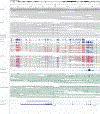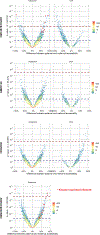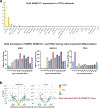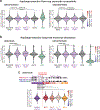Synchronized long-read genome, methylome, epigenome and transcriptome profiling resolve a Mendelian condition
- PMID: 39880924
- PMCID: PMC12077378
- DOI: 10.1038/s41588-024-02067-0
Synchronized long-read genome, methylome, epigenome and transcriptome profiling resolve a Mendelian condition
Abstract
Resolving the molecular basis of a Mendelian condition remains challenging owing to the diverse mechanisms by which genetic variants cause disease. To address this, we developed a synchronized long-read genome, methylome, epigenome and transcriptome sequencing approach, which enables accurate single-nucleotide, insertion-deletion and structural variant calling and diploid de novo genome assembly. This permits the simultaneous elucidation of haplotype-resolved CpG methylation, chromatin accessibility and full-length transcript information in a single long-read sequencing run. Application of this approach to an Undiagnosed Diseases Network participant with a chromosome X;13-balanced translocation of uncertain significance revealed that this translocation disrupted the functioning of four separate genes (NBEA, PDK3, MAB21L1 and RB1) previously associated with single-gene Mendelian conditions. Notably, the function of each gene was disrupted via a distinct mechanism that required integration of the four 'omes' to resolve. These included fusion transcript formation, enhancer adoption, transcriptional readthrough silencing and inappropriate X-chromosome inactivation of autosomal genes. Overall, this highlights the utility of synchronized long-read multi-omic profiling for mechanistically resolving complex phenotypes.
© 2025. The Author(s), under exclusive licence to Springer Nature America, Inc.
Conflict of interest statement
Competing interests: J.K., J.G.U., C.T.S., A.M.W., M.K. and I.J.M. are full-time employees at PacBio, a company developing single-molecule sequencing technologies. A.B.S. is a co-inventor on a patent relating to the Fiber-seq method (US17/995,058). The remaining authors declare no competing interests.
Figures















Update of
-
Synchronized long-read genome, methylome, epigenome, and transcriptome for resolving a Mendelian condition.bioRxiv [Preprint]. 2023 Sep 27:2023.09.26.559521. doi: 10.1101/2023.09.26.559521. bioRxiv. 2023. Update in: Nat Genet. 2025 Feb;57(2):469-479. doi: 10.1038/s41588-024-02067-0. PMID: 37808736 Free PMC article. Updated. Preprint.
References
-
- Cohen ASA et al. Genomic answers for children: Dynamic analyses of >1000 pediatric rare disease genomes. Genet Med 24, 1336–1348 (2022). - PubMed
Methods-only references
-
- Dubocanin D et al. Single-molecule architecture and heterogeneity of human telomeric DNA and chromatin. bioRxiv 2022.05.09.491186 (2022) doi:10.1101/2022.05.09.491186. - DOI
-
- Poplin R et al. A universal SNP and small-indel variant caller using deep neural networks. Nat Biotechnol 36, 983 (2018). - PubMed
MeSH terms
Grants and funding
- 1U01HG010233/U.S. Department of Health & Human Services | NIH | National Human Genome Research Institute (NHGRI)
- 1DP5OD029630/U.S. Department of Health & Human Services | NIH | National Human Genome Research Institute (NHGRI)
- K99 GM155552/GM/NIGMS NIH HHS/United States
- DP5 OD029630/OD/NIH HHS/United States
- U01 HG010233/HG/NHGRI NIH HHS/United States
- U01 HG011744/HG/NHGRI NIH HHS/United States
- U01 NS134355/NS/NINDS NIH HHS/United States
- Career Award for Medical Scientists/Burroughs Wellcome Fund (BWF)
- U01 HG007530/HG/NHGRI NIH HHS/United States
- HG006493/U.S. Department of Health & Human Services | NIH | National Human Genome Research Institute (NHGRI)
- U01 HG007942/HG/NHGRI NIH HHS/United States
- T32 GM007454/GM/NIGMS NIH HHS/United States
- U24 HG011746/HG/NHGRI NIH HHS/United States
LinkOut - more resources
Full Text Sources
Research Materials
Miscellaneous

